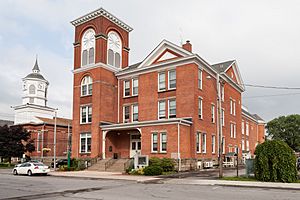Fredonia Opera House facts for kids
The Fredonia Opera House, built in 1891, is a special place in downtown Fredonia, New York. It's located inside the Village Hall at 9-11 Church St. Today, it's a busy performing arts center that's open all year. You can watch live shows, see independent and foreign movies, and it's also used for community meetings, debates, weddings, and other events.
Contents
Designing the Opera House
The person who designed the Village Hall was an architect named Enoch A. Curtis. He was quite famous in the area. For the outside of the building and the office areas inside, he used a style called "Queen Anne eclectic style".
Special Touches in the Theatre
However, when it came to the Opera House itself, Mr. Curtis was more creative. He took ideas from famous old theatres in Europe and New York. He used new technology of the time to create these designs with materials that weren't too expensive.
You can still see these special features today. There's a beautiful curved balcony shaped like a horseshoe. The boxes and the front of the balcony have lovely carved wood. There's also a big, fancy metal arch called a proscenium around the stage. These parts remind us of grand theatres from around the world.
Changes Over Time
The hall first had a painted plaster ceiling. But it got damaged by water. So, in 1903, it was replaced with the tin ceiling you see now, which has also been fixed up. The building was updated several times. In the early 1900s, the gas lights were slowly replaced with electric lights.
In 1926, the old wooden folding chairs were swapped for bigger, more comfortable seats from the Heywood-Wakefield Company. Many of these seats are still there today. New stairs were added to the balcony, and a projection booth for movies was installed. Over time, the windows in the main hall were covered up.
Sadly, the Opera House was neglected for many years. By 1981, it was in such bad shape that it had to close its doors.
A Grand Opening Night
The Fredonia Opera House officially opened in April 1891 with a huge celebration. Guests from all over the region dressed up smartly for the event. They enjoyed an exciting show called "Josephine, Empress of the French."
A Community Dream
This opening night was a dream come true for the village leaders. They had always planned for a grand building overlooking Barker Commons, which is the village square. From the very beginning, this plan included an Opera House. Many communities in the late 1800s shared this dream. With railroads making travel easier, people in smaller towns could now enjoy performing arts and events that used to only be in big cities.
Entertainment for Everyone
Fredonia's Opera House was a very large and elegant theatre for the community. It could host many different kinds of activities. For almost 100 years after it opened, it enriched the lives of nearly everyone in the village.
Many famous entertainers from the late 1800s and early 1900s performed here because of the excellent sound quality. Well-known people like Clara Morris, James O'Neill, and Pat Rooney performed on its stage. There were shows with both professional and local performers. These included musical shows, light operas, and plays like "Hamlet" and "Uncle Tom's Cabin."
The Opera House also hosted music concerts, political speeches, school graduations, and religious services. There were even demonstrations of wrestling and cooking! Older residents of Fredonia remember being in talent shows there, with tap dancing and singing. From the early 1900s onward, movies became more popular. After 1926, even though live shows continued, movies were the main attraction.
Bringing the Opera House Back to Life
In 1983, there was a plan to tear down the building. This idea caused a big public outcry. In response, the Fredonia Preservation Society was formed. This group worked hard to save and restore the building.
Community Support for Restoration
In 1985, the Village Trustees decided to raise money to fix up the administrative parts of the building. This decision was strongly supported by the public in a vote. At that time, the Fredonia Preservation Society promised to raise money specifically for the Opera House.
They raised funds through a local campaign, a grant from the New York State Office of Parks, Recreation and Historic Preservation, and other state grants. The Gebbie Foundation and the Village itself also helped. Many volunteers gave their time and materials, which was a huge help.
About $900,000 was raised in total. After almost ten years of restoration work, the Opera House reopened. It is now ready to serve the community for another century as a cultural center for many different purposes.


